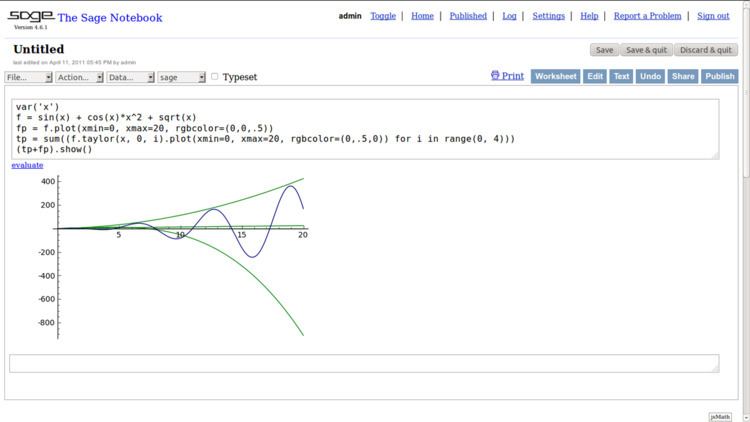 | ||
Initial release 24 February 2005; 12 years ago (2005-02-24) Stable release 7.6 / 25 March 2017; 1 day ago (2017-03-25) Preview release 7.6.rc2 / 19 March 2017; 7 days ago (2017-03-19) Repository git.sagemath.org/sage.git/ Operating system | ||
SageMath (previously Sage or SAGE, "System for Algebra and Geometry Experimentation") is mathematical software with features covering many aspects of mathematics, including algebra, combinatorics, numerical mathematics, number theory, and calculus.
Contents
- Features
- Development
- Release history
- Achievements
- Performance
- Licensing and availability
- Software packages contained in SageMath
- References
The first version of SageMath was released on 24 February 2005 as free and open source software under the terms of the GNU General Public License version 2, with the initial goals of creating an "open source alternative to Magma, Maple, Mathematica, and MATLAB". The originator and leader of the SageMath project, William Stein, is a mathematician at the University of Washington.
SageMath "uses a Python-like syntax," supporting procedural, functional and object-oriented constructs.
Features
Features of SageMath include:
Development
William Stein realized when designing Sage that there were many open-source mathematics software packages already written in different languages, namely C, C++, Common Lisp, Fortran and Python.
Rather than reinventing the wheel, Sage (which is written mostly in Python and Cython) integrates many specialized mathematics software packages into a common interface, for which a user needs to know only Python. However, Sage contains hundreds of thousands of unique lines of code adding new functions and creating the interface between its components.
SageMath uses both students and professionals for development. The development of SageMath is supported by both volunteer work and grants. However, it was not until 2016 that the first full-time Sage developer was hired (funded by an EU grant). The same year, Stein described his disappointment with a lack of academic funding and credentials for software development, citing it as the reason for his decision to leave his tenured academic position to work full-time on the project in a newly founded company, SageMath, Inc.
Release history
Only the major releases are listed below. SageMath practices the "release early, release often" concept, with releases every few weeks or months. In total, there have been over 300 releases, although their frequency has decreased.
Achievements
Performance
Both binaries and source code are available for SageMath from the download page. If SageMath is built from source code, many of the included libraries such as ATLAS, FLINT, and NTL will be tuned and optimized for that computer, taking into account the number of processors, the size of their caches, whether there is hardware support for SSE instructions, etc.
Cython can increase the speed of SageMath programs, as the Python code is converted into C.
Licensing and availability
SageMath is free software, distributed under the terms of the GNU General Public License version 3. SageMath is available in many ways:
Full documentation for installation is provided at doc.sagemath.org/html/en/installation/
Although Microsoft was sponsoring a native version of SageMath for the Windows operating system, as of 2012 there were no plans for a native port, and users of Windows currently have to use virtualization technology such as VirtualBox to run SageMath. As of SageMath 5.9, it mostly successfully builds on Cygwin.
Linux distributions in which SageMath is available as a package are Mandriva, Fedora, and Arch Linux. It is also available as a dedicated Ubuntu PPA. In Gentoo, it's available via layman in the "sage-on-gentoo" overlay. However, SageMath can be installed to any Linux distribution.
Gentoo prefix also provides Sage on other operating systems.
Software packages contained in SageMath
The philosophy of SageMath is to use existing open-source libraries wherever they exist. Therefore, it uses many libraries from other projects.
